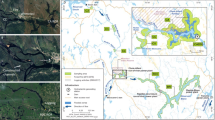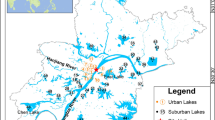Abstract
Nutrient enrichment is considered one of the most important causes for summer hypoxic conditions in the northern Gulf of Mexico (NGOM) off the Louisiana coast. While many studies on nutrient inputs from the large Mississippi-Atchafalaya River System have been conducted, little is known about nutrient inputs from other coastal rivers in Louisiana. In this study, we utilized long-term (1980–2009) records on river discharge and nutrient concentrations of four major Louisiana coastal rivers—the Sabine, Calcasieu, Mermentau, and Vermilion—to estimate daily, monthly, and annual inflows of nitrate and nitrite nitrogen (NO3 + NO2), total Kjeldahl nitrogen (TKN), and total phosphorus (TP) into the NGOM. The three-decade-long nutrient inflows from these rivers were analyzed for their seasonal fluctuations, interannual variabilities, and decadal trends. Fluxes of NO3 + NO2, TKN, and TP for these river basins were estimated to assess land use effects on riverine nutrients. Our study found that the four coastal rivers discharged each year a considerably large amount of NO3 + NO2 (total of 1755 t), TKN (12,208 t), and TP (1833 t) into the NGOM, with a peak input of nitrogen during the spring. The Mermentau and Vermilion Rivers, which drain intensive agriculture areas, had significantly higher NO3 + NO2, TKN, and TP concentrations when compared with the Sabine and Calcasieu Rivers, which drain forest-pasture-dominated lands. The fluxes of NO3 + NO2, TKN, and TP from the Mermentau River Basin (156 kg km−2 year−1 NO3 + NO2, 942 kg km−2 year−1 TKN, and 206 kg km−2 year−1 TP) and the Vermilion River Basin (374, 1078, and 360) were much higher than those combined from the Sabine and Calcasieu River Basins (66, 710, and 62). These findings fill a major knowledge gap concerning the quantity and characteristics of nitrogen and phosphorus transport from coastal watersheds to North America’s largest hypoxic zone.











Similar content being viewed by others
References
Alexander, R. B., & Smith, R. A. (2006). Trends in the nutrient enrichment of U.S. rivers during the late 20th century and their relation to changes in probable stream trophic conditions. Limnology and Oceanography, 51, 639–654.
Bakr, N., Weindorf, D. C., Zhu, Y., Arceneaux, A. E., & Selim, H. M. (2012). Evaluation of compost/mulch as highway embankment erosion control in Louisiana at the plot-scale. Journal of Hydrology, 468–469, 257–267.
Caraco, N. F., & Cole, J. J. (1999). Human impact on nitrate export: an analysis using major world rivers. Ambio, 28, 167–170.
DaSilva, A., Xu, Y. J., Beebe, J., & Ice, G. G. (2013). Effects of timber harvesting on dissolved oxygen in a Northern Louisiana headwater stream. Forest Science, 59, 127–138.
Diaz, R. J., & Rosenberg, R. (2011). Introduction to environmental and economic consequences of hypoxia. International Journal of Water Resources, 27, 71–82.
Dodds, W. K. (2003). Misuse of inorganic N and soluble reactive P concentrations to indicate nutrient status of surface water. Journal of the North American Benthological Society, 22, 171–181.
Gammill, S. (2002). Hydrologic investigation of the Louisiana Chenier Plain. Baton Rouge: Louisiana Department of Natural Resources, Coastal Restoration Division. 1e135 and appendices.
Goolsby, D. A., Battaglin, W. A., Aulenbach, B. T., & Hooper, R. P. (2001). Nitrogen input to the Gulf of Mexico. Journal of Environmental Quality, 30, 329–336.
Goolsby, D.A., Battaglin, W.A., Lawrence, G.B., Artz, R.S., Aulenbach, B.T., Hooper, R.P., Keeney, D.R., Stensland, G.J. (1999). Flux and sources of nutrients in the Mississippi-Atchafalaya River basin. Topic 3 Report of the Integrated Assessment on Hypoxia in the Gulf of Mexico. National Oceanic and Atmospheric Administration Coastal Ocean Program Decision Analysis Series Number 17. NOAA Coastal Ocean Program, Silver Spring, Maryland
Guildford, S. J., & Hecky, R. E. (2000). Total nitrogen, total phosphorus, and nutrient limitation in lakes and oceans: is there a common relationship? Limnology and Oceanography, 45, 1213–1223.
Hill, B. H., Bolgrien, D. W., Herlihy, A. T., Jicha, T. M., & Angradi, T. R. (2011). A synoptic survey of nitrogen and phosphorus in tributary streams and great rivers of the Upper Mississippi, Missouri, and Ohio River Basins. Water, Air, & Soil Pollution, 216, 605–619.
Hodgkiss, I. J., & Ho, K. C. (1997). Are changes in N:P ratios in coastal waters the key to increased red tide blooms? Hydrobiologia, 352, 141–147.
Howarth, R. W., Billen, G., Swaney, D., Townsend, A., Jaworski, N., Lajtha, K., Downing, J. A., Elmgren, R., Caraco, N., Jordan, T., Berendse, F., Freney, J., Kudeyarov, V., Murdoch, P., & Zhao-Liang, Z. (1996). Regional nitrogen budgets and riverine N & P fluxes for the drainages to the North Atlantic Ocean: natural and human influences. Biogeochemistry, 35, 75–139.
Jordan, T. E., Correll, D. L., & Weller, D. E. (1997). Relating nutrient discharges from watersheds to land use and streamflow variability. Water Resources Research, 33, 2579–2590.
Justić, D., Rabalais, N. N., & Turner, R. E. (1995). Stoichiometric nutrient balance and origin of coastal eutrophication. Marine Pollution Bulletin, 30, 41–66.
LDEQ (2000). Recommended forestry best management practices for Louisiana. http://www.ldaf.state.la.us/wp-content/uploads/2014/04/BMP.pdf. Accessed 31 Jul 2015.
LDEQ (2013). Quality assurance project plan for the ambient water quality monitoring network. http://www.deq.louisiana.gov/portal/Portals/0/planning/QAPPs/QAPP_1004_r07%202013%20FINAL%2012-12-13.pdf. Accessed 31 Jul 2015.
Louisiana Census (2010). Population_Place_LA_Census2010. xlsx. http://louisiana.gov/Explore/Demographics_and_Geography/. Accessed 31 Jul 2015.
Narayan, N., & Gillespie, J. (2011). Louisiana crawfish farmer adoption of best management practices. Journal of Soil and Water Conservation, 66, 61–70.
Nichol, S.L., Boyd, R., Penland, S. (1992). Hydrology of a wave-dominated estuary: Lake Calcasieu, southwest Louisiana. Gulf Coast Association of Geological Societies 42: 835–844. http://archives.datapages.com/data/gcags/data/042/042001/pdfs/0835.pdf. Accessed 31 Jul 2015.
O’Connor, T., & Whitall, D. (2007). Linking hypoxia to shrimp catch in the northern Gulf of Mexico. Marine Pollution Bulletin, 54, 460–463.
Obenour, D. R., Scavia, D., Rabalais, N. N., Turner, R. E., & Michalak, A. M. (2013). Retrospective analysis of midsummer hypoxic area and volume in the northern Gulf of Mexico, 1985–2011. Environmental Science & Technology, 47, 9808–9815.
Phillips, J. D. (2003). Toledo bend reservoir and geomorphic response in the lower Sabine river. River Research and Applications, 19, 137–159.
Phillips, D. J. H., & Tanabe, S. (1989). Aquatic pollution in the Far East. Marine Pollution Bulletin, 20, 297–303.
Poudel, D. D., Jeong, C. Y., & DeRamus, A. (2010). Surface run-off water quality from agricultural lands and residential areas. Outlook on Agriculture, 39, 95–105.
Reddy, K. R., & Delaune, R. N. (2008). Biogeochemistry of wetlands: science and applications (p. 267). Boca Raton: CRC. 800 pp.
Redfield, A. C. (1958). The biological control of chemical factors in the environment. American Scientist, 46, 205–211.
Rosen, T., & Xu, Y. J. (2011). Riverine sediment inflow to Louisiana Chenier Plain in the Northern Gulf of Mexico. Estuarine, Coastal and Shelf Science, 95, 279–288.
Saksa, P., Xu, Y.J. (2006). Riverine nutrient inputs to Lake Ponchartrain, Louisiana, USA. Coastal Environment and Water Quality (AIH 25th Anniversary Meeting & International Conference: Changes in Coastal Hydrology and Water Quality), 195–203.
Scavia, D., & Bricker, S. B. (2006). Coastal eutrophication assessment in the United States. Biogeochemistry, 79, 187–208.
Schlesinger, W. H. (1997). Biogeochemistry: an analysis of global change (2nd ed.). San Diego: Academic.
Sloss, R. (1991). Drainage area of Louisiana streams: Louisiana Department of Public Works. Basic records report no. 6, 117 p.
Smith, V. H. (1983). Low nitrogen to phosphorus ratios favor dominance by bluegreen algae in lake phytoplankton. Science, 221, 669–671.
Turner, R. E., & Rabalais, N. N. (1991). Changes in Mississippi river water quality this century. Bioscience, 41, 140–147.
Turner, R. E., & Rabalais, N. N. (1994). Coastal eutrophication near the Mississippi river delta. Nature, 368, 619–621.
Turner, R. E., & Rabalais, N. N. (2004). Suspended sediment, C, N, P, and Si yields from the Mississippi river basin. Hydrobiologia, 511, 79–89.
Turner, R. E., Rabalais, N. N., Alexander, R. B., McIsaac, G., & Howarth, R. W. (2007). Characterization of nutrient, organic carbon, and sediment yields and concentrations from the Mississippi river into the Northern Gulf of Mexico. Estuaries and Coasts, 30, 773–790.
Turner, R. E., Rabalais, N. N., & Justić, D. (2012). Predicting summer hypoxia in the northern Gulf of Mexico: redux. Marine Pollution Bulletin, 64, 319–324.
USACE. (2004). Vermilion river ecosystem restoration report 2/6/2004 (p. 1e16). New Orleans: United States Army Corps of Engineers.
USACE (2015). The Mermentau basin project. United States Army Corps of Engineers, New Orleans, http://www.mvn.usace.army.mil/Portals/56/docs/PAO/Brochures/mermentau.pdf, pp. 1e12. Accessed 31 Jul 2015.
USEPA (2008). Hypoxia in the northern Gulf of Mexico. An update. Science Advisory Board, Hypoxia Assessment Panel, EPA-SAB-08-004 (Washington, DC: USEPA)
USEPA Region 6 (2001). Total maximum daily yield (TMDL) for TSS, turbidity, and siltation for the 15 subsegments in the Vermilion river basin. http://www.epa.gov/waters/tmdldocs/ACFB9BF.pdf. Accessed 31 Jul 2015.
Xu, Y. J. (2006). Total nitrogen inflow and outflow from a large river swamp basin to the Gulf of Mexico. Hydrological Sciences Journal, 51, 531–542.
Xu, Y. J. (2013). Transport and retention of nitrogen, phosphorus and carbon in North America’s largest river swamp basin, the Atchafalaya river basin. Water, 5, 379–393.
Xu, Y. J., & Rutherford, D. A. (2005). Final report on analyses of LDAF 2003/2004 survey on forestry BMP implementation in Louisiana. Baton Rouge: Louisiana Department of Agriculture and Forestry. 37 p.
Acknowledgments
This study was financially supported through grants from the National Fish and Wildlife Foundation (Project no.: 8004.12.036402) and the United States Department of Agriculture Hatch Funds (Project no.: LAB94230). Thanks also go to the United States Geological Survey and the Louisiana Department of Environmental Quality for making the long-term river discharge records and water quality data available for this study.
Author information
Authors and Affiliations
Corresponding author
Rights and permissions
About this article
Cite this article
He, S., Xu, Y.J. Three Decadal Inputs of Nitrogen and Phosphorus from Four Major Coastal Rivers to the Summer Hypoxic Zone of the Northern Gulf of Mexico. Water Air Soil Pollut 226, 311 (2015). https://doi.org/10.1007/s11270-015-2580-6
Received:
Accepted:
Published:
DOI: https://doi.org/10.1007/s11270-015-2580-6




